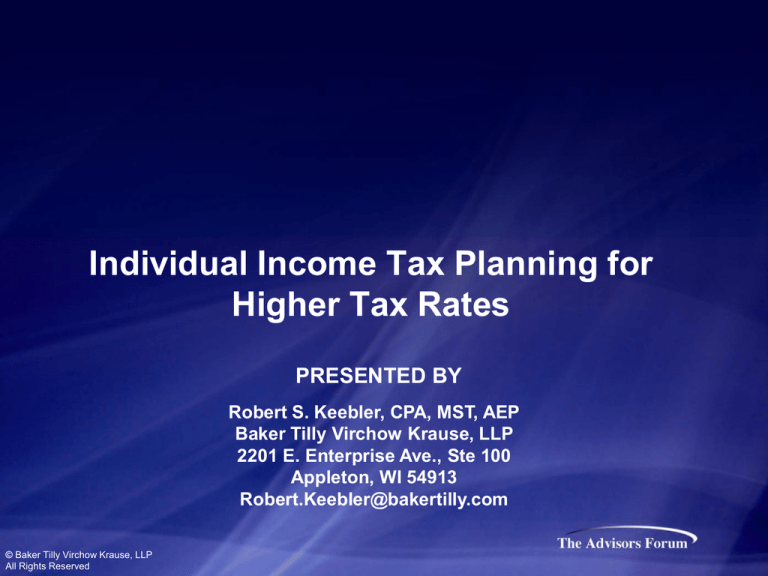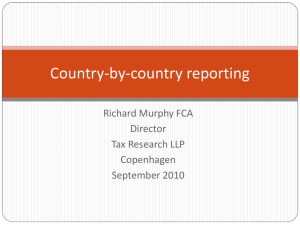
Individual Income Tax Planning for
Higher Tax Rates
PRESENTED BY
Robert S. Keebler, CPA, MST, AEP
Baker Tilly Virchow Krause, LLP
2201 E. Enterprise Ave., Ste 100
Appleton, WI 54913
Robert.Keebler@bakertilly.com
© Baker Tilly Virchow Krause, LLP
All Rights Reserved
Tax Planning Opportunities
• Compensatory stock options
• Roth IRA Conversions
© Baker Tilly Virchow Krause, LLP
All Rights Reserved
2
Outline
• Compensatory stock options
• Financial & tax planning issues
• Hedging using collars
© Baker Tilly Virchow Krause, LLP
All Rights Reserved
3
Compensatory Stock Options
© Baker Tilly Virchow Krause, LLP
All Rights Reserved
4
Compensatory Stock Options
Non-Qualified Stock Options (NQSOs)
• Any stock option that does not qualify for special tax treatment
under IRC §422
• May be transferable
• No specific holding period requirements
• Employer receives an income tax deduction for the difference
between the strike price and the fair market value of the
securities on the date of exercise
© Baker Tilly Virchow Krause, LLP
All Rights Reserved
5
Compensatory Stock Options
Non-Qualified Stock Options (NQSOs)
“Cashless Exercise”
• The exchange of previously acquired stock (not subject to any holding
period requirement) for the funding price of new shares is a tax-free
exchange.
• The basis and holding period of the old stock are carried over (i.e.
“tacked”) to the same number of shares acquired in the exchange.
• The basis in the excess shares is equal to the income recognized on
the transaction (the fair market value), and the holding period begins
with the date of exercise.
© Baker Tilly Virchow Krause, LLP
All Rights Reserved
6
Compensatory Stock Options
Non-Qualified Stock Options (NQSOs)
Tax Consequences
• Ordinary income is recognized on the difference between the strike price
•
•
•
•
and the fair market value of the stock on the exercise date.
FICA and Medicare are applicable to the ordinary income.
The subsequent appreciation will be subject to capital gain. The holding
period will determine whether the gain will be long-term or short-term.
The holding period for purposes of determining the correct capital gain
rate begins with the exercise date.
The basis of the stock is the exercise price plus the amount of income
recognized upon the exercise of the option.
© Baker Tilly Virchow Krause, LLP
All Rights Reserved
7
Compensatory Stock Options
Non-Qualified Stock Options (NQSOs)
$100
Tax Consequences
FMV at sale
FMV at exercise
Short or longterm capital gain
Compensation
income
$0
Strike price
© Baker Tilly Virchow Krause, LLP
All Rights Reserved
8
Compensatory Stock Options
Exercise Considerations
• Opinion of experts
• Historical returns
• Fundamental analysis--look at data about company, ratios,
statistics, etc.
• Security market line
• Importance of expert investment counsel to your client
• Important for setting inputs for option exercise model
© Baker Tilly Virchow Krause, LLP
All Rights Reserved
9
Compensatory Stock Options
Early Exercise Considerations
•
•
•
•
•
•
•
•
Forfeit time value of option
Differential tax consequences favor early exercises)
Dividends on underlying stock
Cash flow situation
Price change expectations for underlying stock
Better investment is available--exercise, sell and reinvest
Possible future change in tax rates
Employer stock ownership requirements
© Baker Tilly Virchow Krause, LLP
All Rights Reserved
10
Financial & Tax Planning
Issues
© Baker Tilly Virchow Krause, LLP
All Rights Reserved
11
Financial & Tax Planning Issues
Risk Factors
•
•
•
•
•
•
Financial stability of employer
Investments within the deferred compensation plan
Executive’s financial exposure
Executive’s financial condition aside from deferred compensation
Federal and state tax issues
Executive’s estate planning goals and objectives
© Baker Tilly Virchow Krause, LLP
All Rights Reserved
12
Financial & Tax Planning Issues
Investments Within Plan
• Determining the proper mix of investments within the plan
• May be prudent to structure investment mix similar to that in a
traditional IRA
• If executive receives company stock, diversification again is central
© Baker Tilly Virchow Krause, LLP
All Rights Reserved
13
Financial & Tax Planning Issues
Executive’s Exposure to Company Stock
• Risk of stock stagnation
• Risk of falling stock value
© Baker Tilly Virchow Krause, LLP
All Rights Reserved
14
Financial & Tax Planning Issues
Executive’s Exposure to Company Stock - Example
Company A is valued at $100. Company A's stock grows 6% for 5 years
followed by 10% growth for 15 years. Compare these results to S & P 500
return (10%) for the 20 period.
650
600
550
500
450
400
350
300
250
200
150
100
50
6% (5 years)
10% (15years)
S&P 500
1
© Baker Tilly Virchow Krause, LLP
All Rights Reserved
2
3
4
5
6
7
8
9 10 11 12 13 14 15 16 17 18 19 20
15
Hedging Using Collars
© Baker Tilly Virchow Krause, LLP
All Rights Reserved
16
Hedging Using Collars
“Cashless” Collars
A “cashless” collar involves the simultaneous combination of a put option
(an option to sell a stock at a predetermined price in the future) and a call
option (an option to purchase a stock at a predetermined price in the future)
on the same underlying stock
• The put option is purchased by the stockholder to provide downside protection
- The put option eliminates any loss below put strike price
• The call option is sold by the stockholder to finance the cost of the put option
- The call option eliminates any gain above call strike price
© Baker Tilly Virchow Krause, LLP
All Rights Reserved
17
Hedging Using Collars
“Cashless” Collars
Settlement Options
• Cash
• Physical settlement
© Baker Tilly Virchow Krause, LLP
All Rights Reserved
18
Hedging Using Collars
“Cashless” Collars
Gain/Loss
Economics of Hedging Strategy
60%
50%
40%
30%
20%
10%
0%
-10%
Downside
-20%
Savings
-30%
-40%
-50%
-60%
$40
$60
Foregone
Gain
$80
$100
$120
$140
$160
Stock Value
Long Stock Position
© Baker Tilly Virchow Krause, LLP
All Rights Reserved
Long Position With Collar
19
Hedging Using Collars
“Cashless” Collars
Advantages:
• Downside protection
• Retain ownership of stock (keep right to dividends and
to vote stock)
• Downside put protection makes it easier to borrow
against stock (monetization potential) (50% maximum)
• Retain some upside potential
• Defer capital gains--further deferral if cash settled
© Baker Tilly Virchow Krause, LLP
All Rights Reserved
20
Hedging Using Collars
“Cashless” Collars
Disadvantages:
• Lose upside potential above call strike price
• Must post underlying shares as collateral for call options
sold
• Some tax risk--rules not clear until regulations are issued
• Unfavorable straddle rules may apply for tax purposes
• Dealer profit
• May be forced to make physical delivery of underlying
stock and recognize gain
© Baker Tilly Virchow Krause, LLP
All Rights Reserved
21
Hedging Using Collars
Constructive Sale Rules – IRC §1259
• If taxpayer has an appreciated financial position and
• Taxpayer enters into transaction that eliminates
substantially all chance of future gain/loss, then
• Taxpayer is treated as making a constructive sale
© Baker Tilly Virchow Krause, LLP
All Rights Reserved
22
Hedging Using Collars
Constructive Sale Rules – IRC §1259
• Applies if collar is too tight
• 20% total spread generally considered permissible
• Total spread can be on put, call, or some combination
© Baker Tilly Virchow Krause, LLP
All Rights Reserved
23
Hedging Using Collars
Straddle Rules – IRC §1092
• Taxpayer has offsetting positions (i.e. value of one
•
•
position goes up while the value of the other position
goes down)
Loss cannot be recognized until all gain in offsetting
positions is recognized
Gain is short-term and recognized immediately
NOTE: One of the positions will be the long position in the stock.
The put and call are not off setting to each other--run in the same
direction.
© Baker Tilly Virchow Krause, LLP
All Rights Reserved
24
Hedging Using Collars
Straddle Rules – IRC §1092
Cash Settlement - Taxation
• Excess of stock price over call price paid to counter party, resulting in
an economic loss, is deferred until underlying stock is sold.
• Cash received for call option that lapses selling is recognized
currently as short-term capital gain income
• Excess of put price over stock price recognized currently as shortterm capital gain income
• Cash paid for put option that is not exercised is deferred until
underlying stock is sold
© Baker Tilly Virchow Krause, LLP
All Rights Reserved
25
Hedging Using Collars
Straddle Rules – IRC §1092
Example #1
Stock Price
Put Strike Price
Call Strike Price
Cost of Put
Cost of Call
$
54.00
49.00
67.00
6.00
6.00
Price Stays @ $54
$6 Short-term capital gain on sale of call - recognized currently
$6 Long-term capital loss on purchase of put - deferred until
underlying stock is sold
© Baker Tilly Virchow Krause, LLP
All Rights Reserved
26
Hedging Using Collars
Straddle Rules – IRC §1092
Example #2
Stock Price
Put Strike Price
Call Strike Price
Cost of Put
Cost of Call
$
54.00
49.00
67.00
6.00
6.00
Price Drops to $29
$20 received from counterparty ($49 put price - $29 current
price), less $6 basis in put option, is recognized immediately
as short-term capital gain
The $6 received from call is a short-term capital gain
© Baker Tilly Virchow Krause, LLP
All Rights Reserved
27
Hedging Using Collars
Straddle Rules – IRC §1092
Stock Price
Put Strike Price
Call Strike Price
Cost of Put
Cost of Call
Example #3
$
54.00
49.00
67.00
6.00
6.00
Price Rises to $87
$14 loss for having to pay counterparty for difference (i.e. $87
market price - $67 call price - $6 received for call option) may
not be deducted until stock is sold
The $6 paid for put is deferred as a long-term capital loss (until
underlying stock is sold)
© Baker Tilly Virchow Krause, LLP
All Rights Reserved
28
Conclusion
© Baker Tilly Virchow Krause, LLP
All Rights Reserved
29
Pursuant to the rules of professional conduct set forth in Circular 230, as promulgated by the
United States Department of the Treasury, nothing contained in this communication was
intended or written to be used by any taxpayer for the purpose of avoiding penalties that may
be imposed on the taxpayer by the Internal Revenue Service, and it cannot be used by any
taxpayer for such purpose. No one, without our express prior written permission, may use or
refer to any tax advice in this communication in promoting, marketing, or recommending a
partnership or other entity, investment plan or arrangement to any other party.
Although effort was taken to ensure the accuracy of these materials, Robert S. Keebler and
Baker Tilly Virchow Krause, LLP assume no responsibility or liability for an individual’s reliance
on these materials. These materials are being provided for educational and informational
purposes only and are in no way to be construed as accounting, financial, tax, legal or other
advice.
Individual readers must consult their own professional tax and legal advisors.
© Baker Tilly Virchow Krause, LLP
All Rights Reserved
30
To be added to our IRA update newsletter,
please email
robert.keebler@bakertilly.com
© Baker Tilly Virchow Krause, LLP
All Rights Reserved
31









